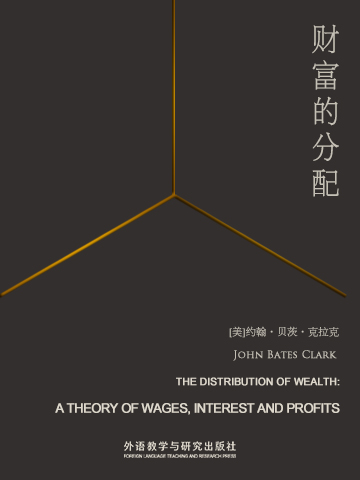本书承袭了萨伊的劳动、资本和土地共同创造价值的庸俗思想,又把报酬递减规律推广到了一切产业部门提出了劳动和资本的边际生产力决定工资和利息的分配理论。该书最早区分了静态经济学和动态经济学,对20世纪30年代以来的西方动态经济学的研究和发展起到了重要作用。
《财富的分配》一书是美国第一代经济学家约翰·贝茨·克拉克的代表作,作者在本书中提出了“边际生产力”的理论,奠定了美国经济学的理论基础,全书是以静态经济学作为研究的对象,论述了边际生产率说,被誉为“以现代方式出现的第一部主要的美国著作”。正是这部著作,开创了“美国学派”,同时也使克拉克成为边际学派在美国的首要代表。
- 第一章 分配的相关问题
- 第二章 分配在传统经济学各分支学科中的地位
- 第三章 分配在经济学各自然分支学科中的地位
- 第四章 一般经济规律中分配的基础
- 第五章 实际分配——社会组织的结果
- 第六章 社会进步所产生的影响
- 第七章 静态社会状态下的工资——独特的劳动产品
- 第八章 如何区别劳动的具体产品
- 第九章 资本与资本货物的区别
- 第十章 资本和资本货物的种类
- 第十一章 社会劳动生产率是由社会劳动和资本在数量上的关系决定的
- 第十二章 工资和利息的调节者——最终生产率
- 第十三章 按地租公式计量劳动和资本的产量
- 第十四章 各行各业的收入
- 第十五章 消费者财富的边际效率——小组分配的基础
- 第十六章 如何计量消费者财富的边际效率
- 第十七章 如何检验生产资料最终增量的效率
- 第十八章 通过定性的增量实现资本增长
- 第十九章 产业群之间劳动和资本的分配模式
- 第二十章 资本分配合理,则生产与消费协调
- 第二十一章 经济因果关系理论
- 第二十二章 应用于具体工具产品的经济因果关系规律
- 第二十三章 各种租金价值关系及团体分配关系
- 第二十四章 衡量产业因素与其产品的单位
- 第二十五章 动态社会的静态标准
- 第二十六章 近似的静态标准
- Chapter I Issues that depend on Distribution
- Chapter II The Place of Distribution within the Traditional Divisions of Economics
- Chapter III The Place of Distribution within the Natural Divisions of Economics
- Chapter IV The Basis of Distribution in Universal Economic Laws
- Chapter V Actual Distribution the Result of Social Organization
- Chapter VI Effects of Social Progress
- Chapter VII Wages in a Static State the Specific Product of Labor
- Chapter VIII How the Specific Product of Labor may be distinguished
- Chapter IX Capital and Capital-Goods contrasted
- Chapter X Kinds of Capital and of Capital-Goods
- Chapter XI The Productivity of Social Labor Dependent on its Quantitative Relation to Capital
- Chapter XII Final Productivity the Regulator of Both Wages and Interest
- Chapter XIII The Products of Labor and Capital, as measured by the Formula of Rent
- Chapter XIV The Earnings of Industrial Groups
- Chapter XV The Marginal Efficiency of Consumers' Wealth the Basis of Group Distribution
- Chapter XVI How the Marginal Efficiency of Consumers' Wealth is measured
- Chapter XVII How the Efficiency of Final Increments of Producers' Wealth is tested
- Chapter XVIII The Growth of Capital by Qualitative Increments
- Chapter XIX The Mode of apportioning Labor and Capital among the Industrial Groups
- Chapter XX Production and Consumption synchronized by rightly Apportioned Capital
- Chapter XXI The Theory of Economic Causation
- Chapter XXII The Law of Economic Causation applied to the Products of Concrete Instruments
- Chapter XXIII The Relation of All Rents to Value and thus to Group Distribution
- Chapter XXIV The Unit for measuring Industrial Agents and their Products
- Chapter XXV Static Standards in a Dynamic Society
- Chapter XXVI Proximate Static Standards
- 书评 写书评
- 笔记
-
书评加载中...


















 京公网安备 11010802032529号
京公网安备 11010802032529号
笔记加载中...